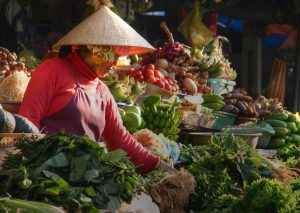The World Bank has downgraded its growth projections for Southeast Asia, due to “multiple shocks” in the global economy, including the war in Ukraine. In its latest economic outlook for the East Asia and the Pacific, released yesterday, the World Bank forecast region-wide growth of 5 percent this year, down from a forecast of 5.4 percent in its last outlook in October. Its “low case” scenario foresees growth dipping to 4 percent in 2022.
“Just as the economies of East Asia and the Pacific were recovering from the pandemic-induced shock, the war in Ukraine is weighing on growth momentum,” Manuela Ferro, the World Bank’s vice president for East Asia and Pacific, said in a statement accompanying the report’s release.
The report forecasts slower growth and rising poverty in the Asia-Pacific region this year due to three interrelated shocks: monetary tightening in the United States, designed to tame a spike in inflation; slowing growth in China; and the aftershocks of the war in Ukraine.
“These shocks are likely to magnify existing post-COVID difficulties,” it states. Struggling regional firms, more than 50 percent of which reported payment arrears in 2021, will be hit by new supply and demand shocks. Households, whose 8 million members fell back into poverty during the pandemic, will see real incomes shrink even further as prices soar.” At the same time, it added, indebted governments, who have taken on addition debt during the COVID-19 pandemic, will “struggle to provide economic support” to those who most need it.
All of these impacts will be felt in Southeast Asia, to varying extents. According to the World Bank, the nations that will see the largest growth in 2022 are the Philippines (5.7 percent, down 0.1 percent from October), Malaysia (5.5 percent, down 0.3 percent), and Vietnam (5.3 percent, down 1.2 percent), and Indonesia (5.1 percent, down 0.1 percent). These are followed by Laos, which is projected to grow by 3.8 percent in 2022, 0.7 percent less than October’s projection, and Cambodia (4.5 percent), whose growth remains steady from the World Bank’s last outlook.
Coming a fair way behind these nations is Thailand, where Chinese “zero COVID” policies and Russian sanctions have slowed recovery of the pivotal tourist industry from the pandemic recession. The World Bank predicts the Thai economy to grow by 2.9 percent in 2022, down by 0.7 percent from its earlier projection. Meanwhile, Myanmar’s economy is expected to grow by an anemic 1 percent in 2022, following a colossal 18 percent contraction in 2021 due to the military coup and ensuing crisis. (The World Bank did not make a projection for Myanmar in its October outlook, due to the uncertain political situation.) Aside from Myanmar, the worst performing Southeast Asian nations will be Timor-Leste, which is projected to grow by just 2.4 percent in 2022, 1.3 percent less than the Bank’s October projection.
The World Bank report details the concrete impact that rising prices in particular could have on the poor of the region. While the region’s direct dependence on Russia and Ukraine for imports and exports of goods, services, and capital, is limited, “the war and sanctions are likely to increase international prices of food and fuel, hurting consumers and growth.”
It estimates that a 10 percent rise in cereal prices over the course of the year could increase the number of poor in the Philippines by 1 percentage point. Similarly, a 10 percent fuel increase in 2022 could lead to a reduction in national income of 0.7 percent in commodity importing nations like Cambodia and Thailand.
How hard countries are impacted could reflect the degree of their reliance on short term capital flows, which could be impacted by a potential monetary tightening in the United States, as well as the degree of reliance on trade with China. When it comes to rising international prices triggered by the war in Ukraine, commodity exporters, like Indonesia and Malaysia, may absorb this with less difficulty than commodity importers. But given the febrile state of play in Ukraine, there is every likelihood that the World Bank may end up revising these numbers downward again in six months’ time.

































